Chilly Swim
How swimbaits in the cold months can boat you a limit … or the biggest fish of your life
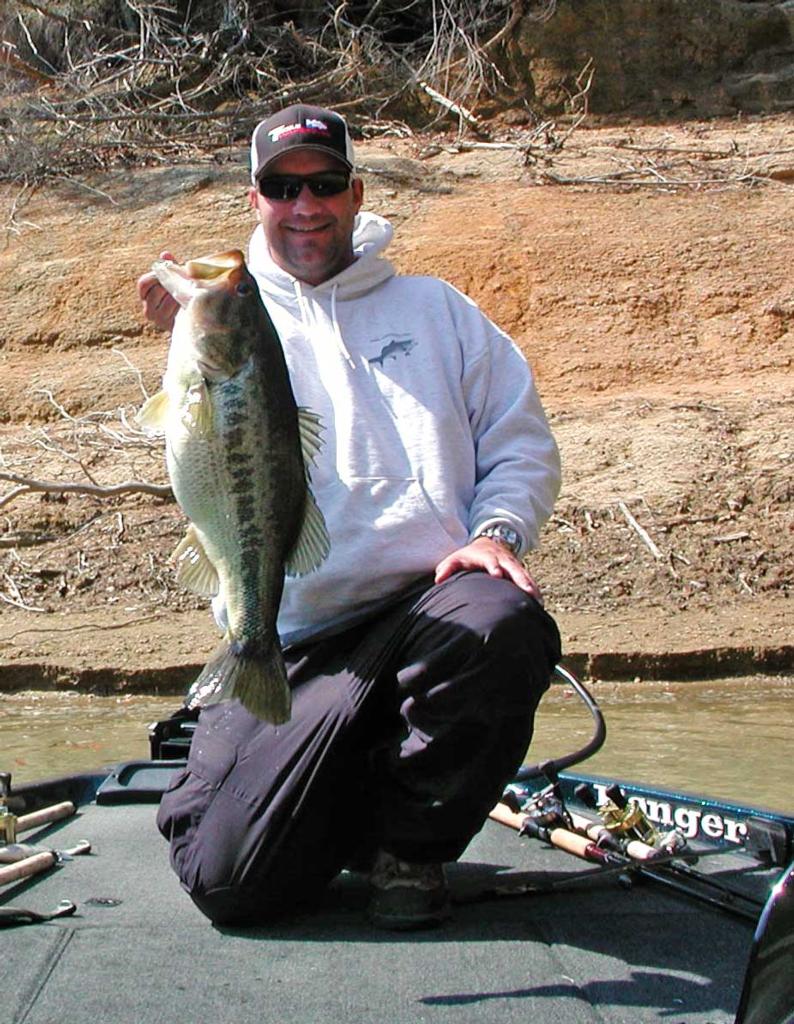
(Editor’s note: The following article appeared in the November/December 2012 issue of FLW Bass Fishing magazine).
They’re both transplants, and they both hold a secret for winter fishing.
National Guard pro Justin Lucas and EverStart Series pro Matt Peters of southernswimbait.com both reside in the southeastern U.S. (Alabama and Arkansas, respectively). They didn’t always, though. At one point in time each called California home.
You might know where this is going, because if you know anything about the anglers out West, then you can probably figure out their fishing secret.
Swimbaits. While most anglers rely on jigging spoons and suspending jerkbaits to coax lethargic bass in the dead of winter, these two anglers hearken back to their Western roots and go the swimbait route.
“In the winter, bass are keying on shad,” Lucas says. “Plus, the bass are usually suspended. Both are perfect scenarios for swimbaits. The usual ways of winter fishing have their place, especially in water colder than 45 degrees. But if it’s warmer than that, swimbaits definitely have their role.”
It’s just a matter of what you’re looking for on a particular day; whether you want to keep warm by stroking a limit or grind it out for the fish of a lifetime.
Going for the Limit
Lucas has little problem chasing giants, but considering he’s a Walmart FLW Tour pro whose livelihood relies on him catching five fish a day instead of one, he typically has to opt for techniques that attract multiple bites.
The Situation
Lucas opts for swimbaits any time he looks at his electronics and sees bass suspended up off the bottom on typical winter spots such as bluff walls, deep humps or deep points with steep drops.
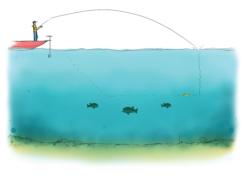 ” border=”1″ align=”left” />“There are only so many ways to catch suspended fish, and throwing swimbaits is one of them,” Lucas says. “You get the right day – those cloudy, warm-front days when it’s five to 10 degrees warmer than the day before seem to be best – and bass are more than willing to jump on a swimbait.”
” border=”1″ align=”left” />“There are only so many ways to catch suspended fish, and throwing swimbaits is one of them,” Lucas says. “You get the right day – those cloudy, warm-front days when it’s five to 10 degrees warmer than the day before seem to be best – and bass are more than willing to jump on a swimbait.”
The Swimbait
When Lucas says “swimbait,” he’s referring to the soft-plastic, paddle-tail variety, such as the Berkley PowerBait Hollow Belly Swimbait. The 4-inch model is his top choice, but he’ll upsize to the 5-incher if he’s catching a lot of fish or if he feels he can target bigger fish.
The Jighead
He’ll rig either size of swimbait on a standard, triangle-shaped, lead-head jig weighing anywhere from 3/8 to 3/4 ounce, depending on the situation.
 The key is matching the correct jighead size to the depth the fish are suspended, while keeping the lure above the fish. So if they’re suspended around 15 feet deep, the swimbait should be traveling a couple of feet above them. Sometimes bass might be suspended at 15 feet in 20 feet of water. Sometimes they might be suspended at 15 feet over 50 feet of water. Regardless, the depth of the fish is what is important.
The key is matching the correct jighead size to the depth the fish are suspended, while keeping the lure above the fish. So if they’re suspended around 15 feet deep, the swimbait should be traveling a couple of feet above them. Sometimes bass might be suspended at 15 feet in 20 feet of water. Sometimes they might be suspended at 15 feet over 50 feet of water. Regardless, the depth of the fish is what is important.
Use a 3/8-ounce head for fishing from the surface to 10 feet deep, a 1/2-ounce head in 10 to 15 feet and a 3/4-ounce head for anything deeper than 15 feet. Lucas doesn’t fish a swimbait much beyond about 30 feet deep.
The other factor to consider is hook size.
“This is probably one of the few times when I’ll go with a 3/0 hook over a 4/0 or 5/0,” Lucas says. “The water in the winter is clearer than any time of the year, and the last thing I want is a huge, gaudy hook sticking out the back of my swimbait. I want it to look as natural as possible.”
The Presentation
To catch suspended bass, cast past the intended target and count the swimbait down to the proper depth. It takes some practice and knowledge of how fast the lure sinks. For instance, Lucas says the 1/2-ounce head he uses sinks at roughly 1 foot per second.
Lucas uses a slow, swimming retrieve that is just fast enough to get the tail to wobble. The only other action is an occasional twitch.
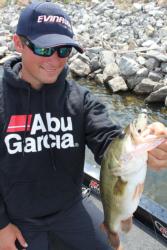 ” border=”1″ align=”left” />“I learned growing up out West that bass follow swimbaits a lot more than people think,” Lucas says. “They look so natural that bass get curious. So I learned to give the lure a little pop with the rod or a quick turn with the reel handle two or three times a cast, as if a fish is following it. I significantly increase my bites by doing that.”
” border=”1″ align=”left” />“I learned growing up out West that bass follow swimbaits a lot more than people think,” Lucas says. “They look so natural that bass get curious. So I learned to give the lure a little pop with the rod or a quick turn with the reel handle two or three times a cast, as if a fish is following it. I significantly increase my bites by doing that.”
Going for the Giant
Peters has nothing against going for a limit, but if he’s going to freeze himself numb in the winter, he’s doing it for a double-digit fish.
“I’m a trophy fisherman,” Peters says. “And that late-winter period when spring is knocking on the door is one of the best times of the year to catch the biggest fish of your life.”
The Swimbait
When Peters says “swimbait,” he’s referring to the large, California-style variety, such as the 8-inch Huddleston Deluxe Trout.
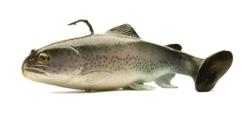 Peters prefers colors that match the forage and ties on two swimbaits with different sink rates: ROF 5 and ROF 12 or 16. ROF stands for “rate of fall,” with the number equating to how deep the lure will have sunk after 10 seconds. The reason for having two choices is to fish a spot quickly and effectively at different depths or speeds.
Peters prefers colors that match the forage and ties on two swimbaits with different sink rates: ROF 5 and ROF 12 or 16. ROF stands for “rate of fall,” with the number equating to how deep the lure will have sunk after 10 seconds. The reason for having two choices is to fish a spot quickly and effectively at different depths or speeds.
The Water
Obviously, most anglers probably don’t own a lure as big as one of the larger Huddleston versions – or perhaps half as big, for that matter – so this is a specialized technique that requires specific tackle for bodies of water that meet certain requirements.
We’ll start with the bodies of water. After moving from California, Peters settled down in Georgia for awhile before relocating to Arkansas. In those three states, he lived in areas with deep, clear reservoirs with blueback herring, rainbow trout or large shad as forage.
“The reservoirs in California, Georgia, the Carolinas, Arkansas and the Ozarks are some of the best for this technique,” Peters says.
The Structure
Peters keeps it simple when it comes to choosing the right offshore structur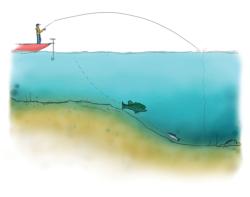 To do it, simply follow the main river channel on the map until it intersects with a steep, offshore structure, such as a hump, point or ledge. The depth of the structure isn’t necessarily as important as the structure itself, since a steep structure will offer enough deep and shallow water for a big bass to find its comfort zone.
To do it, simply follow the main river channel on the map until it intersects with a steep, offshore structure, such as a hump, point or ledge. The depth of the structure isn’t necessarily as important as the structure itself, since a steep structure will offer enough deep and shallow water for a big bass to find its comfort zone.
The Tackle
To heave the heavy swimmers, Peters prefers a Shimano Calcutta TE 400 strapped to an 8-foot G.Loomis swimbait rod. The reel holds 80-pound-test braid with at least 3 feet of 30-pound-test monofilament leader – he opts for mono over fluorocarbon because he wants a little stretch, which helps keep a big lure from breaking off on the cast if the reel backlashes. (Best to practice casting this sort of setup in a football field or park until you master it before trying it on the water.)
The Approach
Once Peters finds a spot, he’ll wait until the afternoon before heading out to fish it – this style of fishing is better in the afternoon, once the day has warmed up a bit.
Stealth is important. Approach within casting distance of the target with the trolling motor – not the big motor – to avoid spooking fish. Position the boat on the shallow side of the structure, which still might be 15 feet deep on some spots, and direct casts out off the break into deep water so the retrieve is coming “uphill.”
Peters usually starts by making four or five casts with the faster-sinking swimbait, counting it down to within 5 to 10 feet of the bottom. He’ll then employ the slowest retrieve possible as he reels it up the break with his rod pointed toward 8 o’clock. Depending on the spot, his lure might run into the bottom at some point, and that’s fine, though he prefers to keep it up off the bottom as much as possible.
If he doesn’t get a bite with the deep-runner, he switches to the shallower model, casting it out, counting it down a couple of seconds and then reeling it back as slowly as possible.
“Some days they’re more active than others, and it’s nothing for them to come up and get a swimbait that’s only 10 feet down over even 50 feet of water,” Peters says. “With that shallow model, when I get a bite, it’s nearly always a really big fish.”
The Finish
When Peters does get a strike, there’s no waiting for the rod to load up as when using some other types of swimbait techniques. He figures anything big enough to hit the lure is big enough to inhale it, and he slams the hooks without fail.
So what are the realistic odds of him getting a chance to set the hook?
“If I fish five days in a week, two or three of them I won’t catch a fish,” Peters says. “But those other days are when I catch a fish bigger than what anyone else catches all year. It’s more than most people can stand, but that’s why I do it. That’s why I throw swimbaits.”
To read all the compelling articles from each month’s edition of FLW Bass Fishing magazine, click here to become a subscriber member.